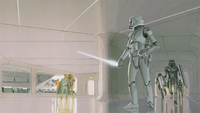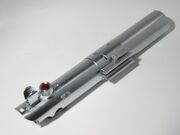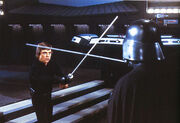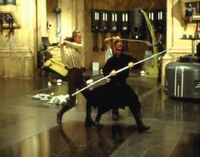| | |
Warning: The following parameters in the infobox are unrecognized: color, era, imageBG
- "This is the weapon of a Jedi Knight. Not as clumsy or random as a blaster. An elegant weapon for a more civilized age."
- ―Obi-Wan Kenobi
The lightsaber, sometimes referred to as a laser sword, was a weapon used by the Jedi and the Sith.[16] Lightsabers consisted of a plasma blade, powered by a kyber crystal[17] and emitted from a metallic hilt.[5] It was a weapon that required skill and training, and was greatly enhanced when used in conjunction with the Force. Though also used by the Sith, the lightsaber was synonymous with the Jedi,[18] with some in the galaxy believing only Jedi used lightsabers.[16]
Lightsabers were generally used both for combat and defense. A lightsaber could cut through virtually anything, from enemies to blast doors.[13] The only ways to block the incoming attack of a lightsaber was with a weapon made with material that conducts energy such as an electrostaff[19] or Z6 riot control baton,[20] or another lightsaber.[5] When used defensively, a skilled user could deflect blaster bolts with a lightsaber, and even reflect the shots back toward the shooter or some other target.[13] Experienced Jedi could even employ their lightsabers to absorb Force lightning.[9] Most practitioners used one single-bladed lightsaber, though some used double-bladed lightsabers[16] or even multiple lightsabers at once.[9]
By approximately thirty years after the death of the Galactic Emperor, Darth Sidious,[21] Kylo Ren wielded a red crossguard lightsaber that extended with two miniature blades.[22]
Mechanics
Metal was usually chosen to make up the hilt, but a casing carved from the Brylark tree, wood that is strong as metal, would also work.[23]. Some hilts were even crafted of gems.[24] The weapon drew power from an appropriately-sized power cell.[25] Parts that will work to make a lightsaber include modulation circuits and an energy gate. Ones that are necessary include a blade emitter shroud, the emitter matrix and some type of activator to turn the weapon on and off. Other parts that could be added include handgrip ridges and a blade length adjuster.[25][26] Single-bladed lightsabers usually had a belt ring so they could be hung from a belt hook, or a wheel-shaped attachment that slotted into a matching belt clip on the owner's belt when not in use.[16][9][27][28][25]
During assembly, it was important to not accidentally invert the emitter matrix; when improperly activated the lightsaber's power grid would backfire. At best this could cause the blade to quickly short out, but if left on the faulty weapon would violently explode, potentially killing those in close proximity.[23]
Specially designed lightsabers could even use unstable crystals, such as Kylo Ren's lightsaber, which featured two laterally facing vents designed to divert access energy away from the cracked crystal and keep the lightsaber stable.[29]
Behind the scenes
Early concepts

Early concept art of lightsabers.
The usage of the lightsaber was originally inspired by many of the serials that George Lucas watched and enjoyed as a child, which featured many characters wielding swords. When he began conceiving Star Wars, he wished to include swords, creating the "lightsaber" to allow them to better mesh with the futuristic setting.[30]
In the early incarnations of the Star Wars storyline, lightsabers were not exclusive to the Jedi and other Force-users, but were in fact very mundane. Early concept art depicts lightsabers being wielded by Rebel and Imperial soldiers alike. George Lucas later limited the lightsabers to exclusively the Jedi in order to make them feel more unusual, and heighten the mystique of the Jedi.[31] Also, in early drafts of the script, lightsabers were referred to as "lazerswords."
Crystals first appear in Star Wars simply as an embedded decoration on the hilt in the original film's novelization. Aside from this single instance, there are no crystals mentioned in any of the movies or their novelizations.[32]
Prop design and effects

A Graflex flash similar to the one used for Luke Skywalker's first lightsaber.
During the filming of A New Hope, the Anakin/Luke lightsaber was made from a Graflex camera side-attach flash, while Darth Vader's lightsaber was made from a Micro Precision Products flash attachment. The handle grips were made with T-shaped pieces of plastic from sliding glass cabinet windows and, contrary to popular belief, were not made with rubber windshield wipers. D-rings were attached to the bottoms of the units so that they could be worn on belts. Obi-Wan Kenobi's lightsaber was the most complex hilt at the time. It was assembled from parts of an Armitage Shanks Starlite model Handwheel, Browning ANM2 machine gun booster, WWI No.3 Mk.1 British Rifle Grenade and a Rolls-Royce Derwent Mk.8/Mk.9 Jet Engine Balance Pipe.
The lightsaber effects during the original trilogy started out in a very complicated manner. During the filming of A New Hope, the blade was made of a three-sided rod covered with reflective material. The rod was then rapidly spun by a compact motor in the hilt, reflecting the lights on set and creating an in-camera glowing effect. However, these props were highly limited; they were cumbersome and fragile, often breaking during fight scenes. Also, the glowing effect was not absolute, as whenever the blade moved out of the light or pointed more directly at the camera the glow disappeared and the actual spinning rod could be seen. In order to partially compensate for this loss of the effect, the blade was rotoscoped and an animated glow was added by tracing onto a blown-up copy of the frame with pen and colored ink, one frame at a time. It was at this phase that blades were given colors, as the props were simple white blades.[30][31]

Mark Hamill and Bob Anderson duel with carbon rods.
During the filming of The Empire Strikes Back, it was decided creating an in-camera glowing effect was more trouble than it was worth, so the spinning rods were swapped for carbon rods. While these new blades were less cumbersome than before, they were still very fragile and frequently broke. However, they continued to be used for Return of the Jedi.[30]
When filming began for The Phantom Menace, the new lightsaber blades were steel and aluminum rods, which were highly durable, but frequently bent and flexed, requiring constant replacement.[33] Despite such a drawback, these rods still saw usage during the filming of Attack of the Clones, as they had no alternative at the time. However, for the filming of Revenge of the Sith, the blades were replaced by carbon fiber rods laminated with glass and plastic. These new props were highly durable and didn't flex, though they were extremely hard, often causing bruising and leaving scars. While lightsaber effects were still done by rotoscoping for the prequels, they were done digitally, rather than by hand.[31]
For The Force Awakens, the lightsaber props actually glowed, giving more of a sense of realism.
Colors
Lightsabers depicted in the first two released films, A New Hope and The Empire Strikes Back, had blades that were colored either blue (for the Jedi) or red (for the Sith). This color difference was a decision during post-production when the lightsaber blades were being rotoscoped, as the original blades were simply white. In Return of the Jedi, Luke Skywalker's newly-constructed lightsaber was colored blue during the initial editing of the film, and appears so in both an early movie trailer and the official theatrical posters, but in the final film, it was ultimately colored green in order to better stand out against the blue sky of Tatooine in outdoor scenes. It also appeared as green in re-release posters.
Both green and blue became standard blade colors for Jedi lightsabers in the Star Wars prequel trilogy. Mace Windu's amethyst-bladed lightsaber, as first seen in Attack of the Clones, was a personal request from actor Samuel L. Jackson as a way to make his character stand out among other Jedi. Jackson's favorite color is purple and he frequently requests the characters he plays to use an item of the color in his movies. In addition, there are orange, yellow, gold, silver, bronze, white(like Ahsoka Tano's dual lightsabers) and the rarest, black.
Choreography

Ray Park practices dueling with the stunt doubles of Liam Neeson and Ewan McGregor.
While the usage of lightsabers was originally inspired by rapiers featured in the old serials George Lucas enjoyed, the final choreography in A New Hope looked nothing like fencing. As Jedi and their Sith counterparts were heavily inspired by samurai, the fighting styles utilized were based more on kendo.[34] The slower, more strength-oriented moves of kendo used in the duel also helped mesh with Lucas' concept that it was a battle between what were essentially two old men.[30]
During the filming of The Empire Strikes Back, Lucas began ramping up the speed of the duels, making them "faster and more intense," the idea being that Luke Skywalker was becoming increasingly proficient with the lightsaber.[30] Also, rather than utilize David Prowse, the actor within the Darth Vader costume, for the duels, they instead had professional swordsman Bob Anderson perform the fights, due to Prowse's tendency to repeatedly break the fragile prop blades. Anderson continued to serve as Prowse's fighting double during the filming of Return of the Jedi.
When filming began for The Phantom Menace, the new stunt coordinator Nick Gillard ramped up the speed and agility the characters demonstrated in lightsaber duels, the idea being that the prequels took place when the Jedi Order was in "full flower," at least in terms of combat techniques.[30] Gillard was careful to avoid giving the fight scenes a choreographed look, drawing upon his extensive knowledge of martial arts to create the moves.[35] The end result was a very fast-paced style of fighting, which he described as being like a chess game between grand masters, with every move being a check. This style of choreography was continued on throughout the prequel trilogy.[35]
